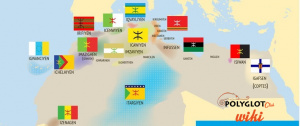Language/Kabyle/Grammar/Plurals
Hi Kabyle learners! 😊
In this lesson, we will learn about plurals in Kabyle grammar. Kabyle nouns have a dual number system, which means that they have two forms: singular and plural. Plural nouns are used when referring to more than one person or thing. Understanding the basics of Kabyle grammar is essential to communicate effectively in this language. Let's get started and explore this topic in detail.
Plural formation
To form the plural in Kabyle, different rules depending on the type of word. Here are the rules that need to be followed to form plurals:
Regular plural formation
The basic rule for forming the regular plural of Kabyle nouns is to add the suffix -en to the singular form.
| Kabyle | Pronunciation | English |
|---|---|---|
| tizlatin (tizlat) | tizla̱tin | house (one) |
| tizlatin-en (tizlaten) | tizla̱tinɛn | houses (more than one) |
Plural formation with prefix
Some Kabyle nouns form the plural by adding a prefix to the singular stem. The prefixes are as follows:
| Prefix | Example |
|---|---|
| ɛn- | azmura (sheep) →ɛnazmuraen (sheep - plural) |
| im- | ishem (sun) → imeshmen (sun - plural) |
| u- | ugezmir (goat) → ugezmiren (goat - plural) |
Irregular plural formation
Some nouns do not follow any rule for making their plurals. They need to be memorized in order to be used properly.
| Kabyle | Pronunciation | English |
|---|---|---|
| ay (yettun) | ay | hand (one) |
| iwad (yewtin) | iwad | river (one) |
| awal (yiwi) | awal | word (one) |
Plural adjective agreement
In Kabyle, adjectives must agree with the noun in number and gender. For example:
| Kabyle | Pronunciation | English |
|---|---|---|
| tayemsa (tayemsat) | taye̱msa | beautiful (one, feminine) |
| tayemsa-en (tayemsatin) | taye̱msanɛn | beautiful (more than one, feminine) |
| aseggas (aseggasen) | ase̱ggas | new (one, masculine) |
| aseggas-en (aseggasenin) | ase̱ggasinɛn | new (more than one, masculine) |
Notice how the adjective agrees with the noun in gender and number.
Examples in context
Here are some examples of plurals in context:
- Person 1: A-Smana yettnadien. (I have two cars.)
- Person 2: Aţţaţţ ifassen-yi iwakken ad yemger di tallunt. (Wow, my friend, they are very nice to put in the garage.)
Translation:
- Person 1: "A-Smana yettnadien." (I have two cars.)
- Person 2: "Aţţaţţ ifassen-yi iwakken ad yemger di tallunt." (Wow, my friend, they are very nice to put in the garage.)
Tips for practicing
To improve your plural formation in Kabyle, try to use plurals in sentences and have conversations with native speakers. You can use the Polyglot Club website to find native speakers and ask them any questions! You can also read articles and books in Kabyle to get used to the different plural forms.
To learn more about Kabyle grammar, check out our Grammar section.
Sources
➡ If you have any questions, please ask them in the comments section below.
➡ Feel free to edit this wiki page if you think it can be improved. 😎

